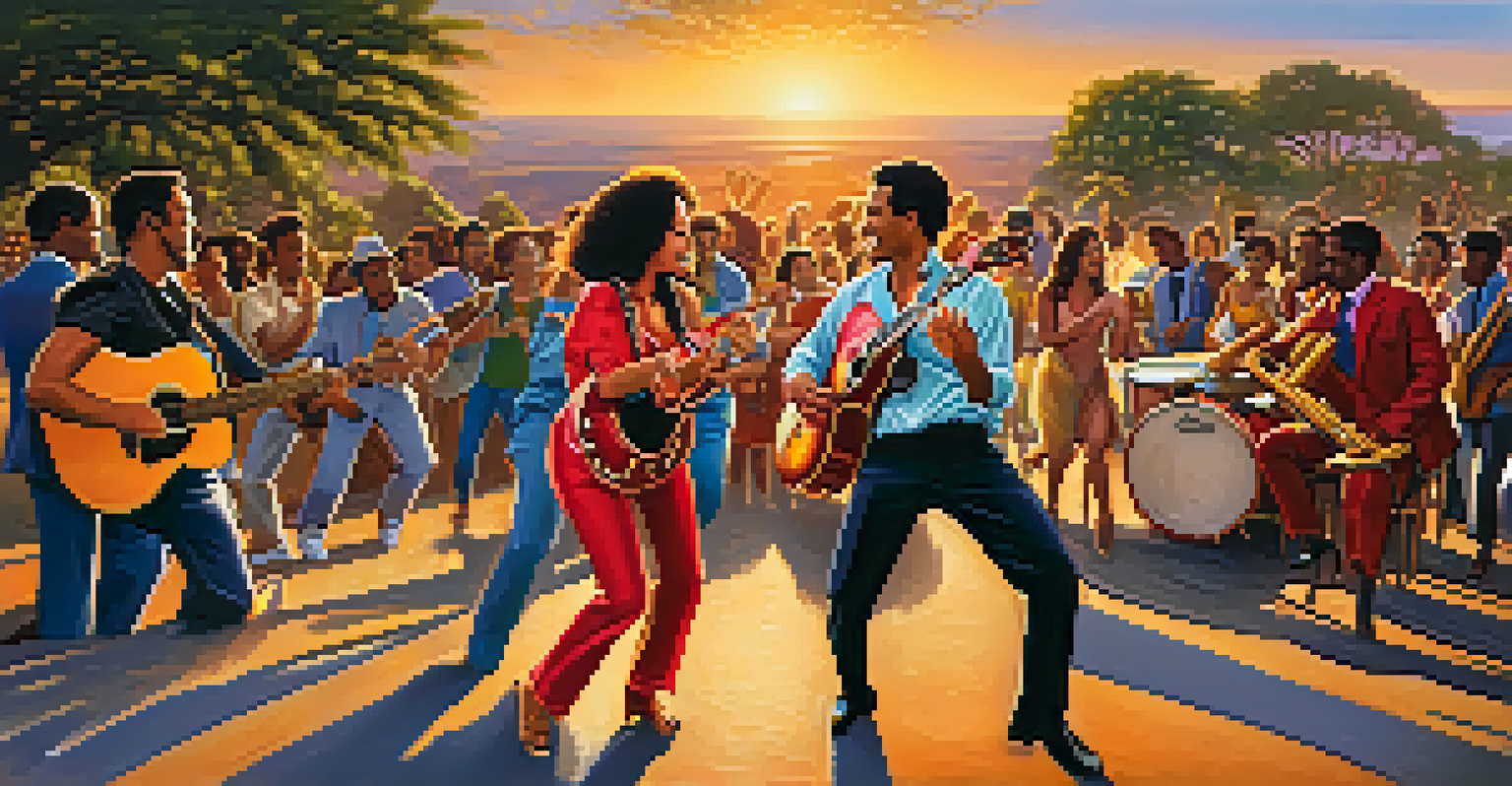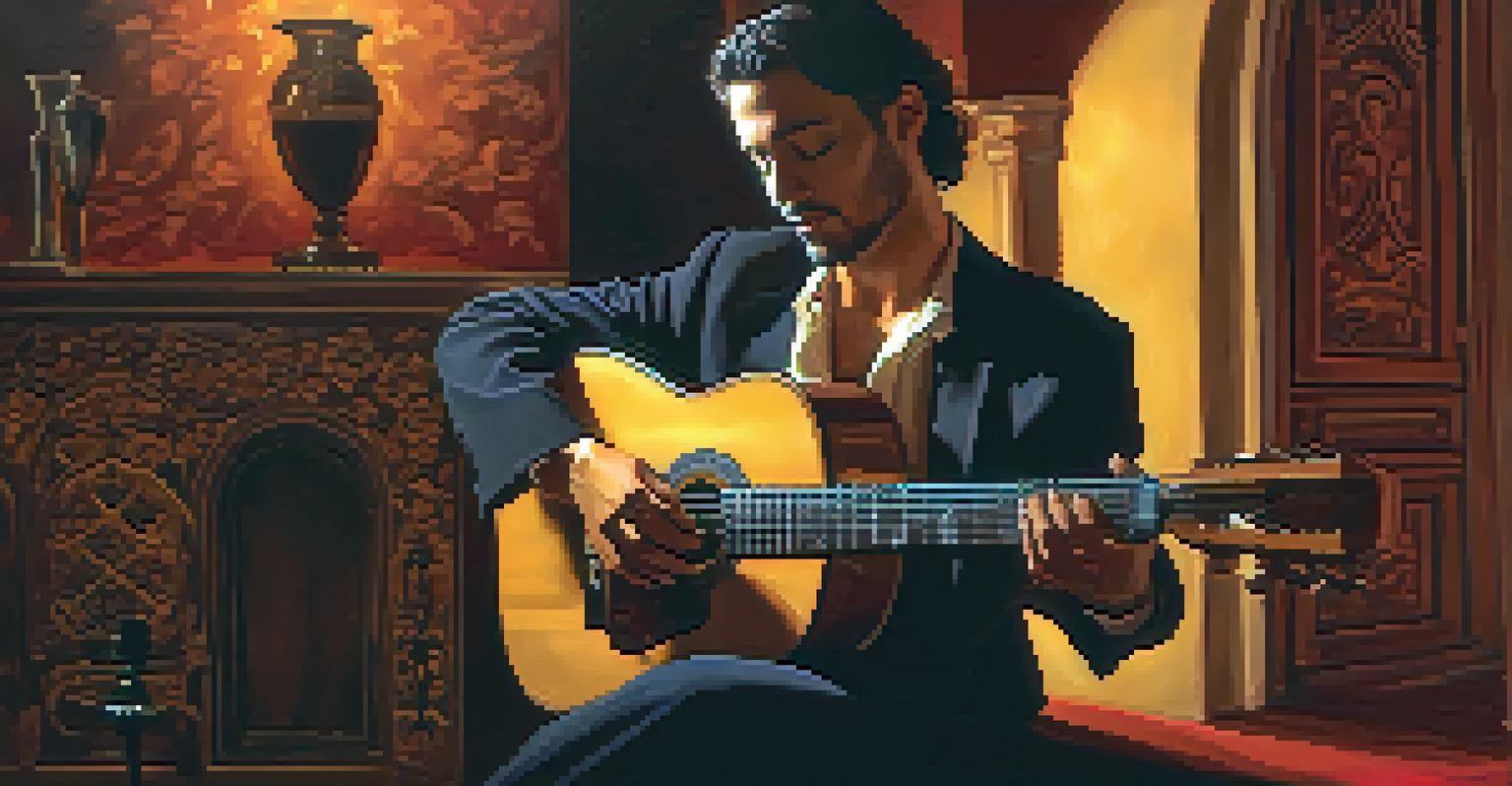Latin American Guitar: Rhythms that Shape Playing Styles

Introduction to Latin American Guitar Styles
Latin American guitar embodies a rich tapestry of rhythms and styles, each reflecting the diverse cultures of the region. From the vibrant sounds of Brazilian bossa nova to the passionate strumming of flamenco in Spain, each style carries its own unique flavor. Understanding these variations is key to appreciating the artistry behind Latin American guitar music.
The guitar is a miniature orchestra in itself.
The guitar serves not just as an instrument, but as a storyteller, conveying emotions and cultural narratives through its strings. Musicians often blend traditional elements with contemporary influences, creating a dynamic soundscape that resonates with audiences worldwide. This fusion has led to the emergence of new genres, enriching the Latin American music scene.
As we dive deeper into the rhythms that shape these playing styles, we will explore how each region's cultural heritage influences guitar techniques and musical expression. This journey will reveal the intricate connections between rhythm, emotion, and identity in Latin American guitar music.
The Role of Rhythm in Latin American Guitar
Rhythm is the heartbeat of Latin American guitar music, driving the melodies and shaping the overall sound. Unlike some Western music forms that prioritize melody, Latin American styles often emphasize complex rhythmic patterns that create a vibrant, energetic feel. This rhythmic foundation is essential for both composition and performance, guiding musicians as they play.

Many Latin American genres, such as samba and tango, utilize polyrhythms, where multiple contrasting rhythms are played simultaneously. This creates a rich textural experience, inviting both musicians and listeners to engage deeply with the music. The interplay of these rhythms can evoke a wide range of emotions, from joy to nostalgia.
Rhythm Drives Latin American Guitar
The intricate rhythms in Latin American guitar music create a vibrant and engaging sound that emphasizes emotional expression.
Understanding rhythm in Latin American guitar is not just about keeping time; it's about feeling the music in your bones. Musicians often use their body movements, such as foot tapping or swaying, to embody the rhythm, making the performance an immersive experience. This connection between body and sound is what makes Latin American guitar so captivating.
Exploring Bossa Nova and Its Unique Rhythms
Bossa nova, which emerged in the late 1950s in Brazil, beautifully blends samba and jazz influences, creating a laid-back yet sophisticated sound. Characterized by its syncopated rhythms and soft melodies, bossa nova is often played on the classical guitar, emphasizing fingerstyle techniques. This gentle approach allows for intricate rhythmic patterns to shine through, making it a favorite among guitarists.
Music is the universal language of mankind.
The iconic bossa nova rhythm can be likened to a gentle wave, flowing smoothly and effortlessly. Musicians often play with a combination of bass notes and higher melodies, creating a lush, harmonic backdrop. This interplay between rhythm and melody is what makes bossa nova so enchanting, drawing listeners into its soothing embrace.
Artists such as João Gilberto and Antonio Carlos Jobim popularized bossa nova, introducing the world to its captivating rhythms. Their compositions remain staples in the guitar repertoire, inspiring new generations of musicians to explore this delicate style. Whether you're a beginner or an experienced player, mastering bossa nova rhythms can elevate your guitar playing to new heights.
The Passionate Strumming of Flamenco
Flamenco guitar is synonymous with passion and intensity, rooted in the traditions of Andalusia, Spain. This style is characterized by rapid strumming patterns, intricate fingerpicking, and a strong sense of rhythm that can be both fierce and expressive. Flamenco musicians often use techniques like 'rasgueado' (strumming) and 'picado' (plucking) to create a dynamic interplay of sound.
The rhythms of flamenco are complex and varied, often based on traditional forms called 'palos.' Each palo has its own unique rhythm and mood, ranging from the lively 'alegrías' to the somber 'soleá.' This diversity allows guitarists to convey a wide spectrum of emotions, making flamenco a deeply personal and expressive art form.
Bossa Nova Blends Samba and Jazz
Bossa nova combines the laid-back essence of samba with jazz influences, resulting in captivating and intricate guitar melodies.
In flamenco, the connection between guitarist and dancer is crucial, as both artists feed off each other's energy. The guitar provides the rhythmic foundation while the dancer interprets the music through movement. This synergy creates a captivating performance that speaks to the heart and soul of Spanish culture.
The Energetic Beats of Salsa Guitar
Salsa music, with its lively rhythms and infectious energy, has become a global phenomenon, and the guitar plays a pivotal role in its sound. Often played alongside brass instruments and percussion, salsa guitar adds a melodic layer that enhances the overall groove. The rhythmic patterns in salsa are typically syncopated, creating a danceable beat that invites everyone to move.
The guitar in salsa can vary in style, from providing rhythmic accompaniment to taking the lead in solos. Musicians often employ techniques such as 'tumbao,' a bass-like pattern that establishes a strong groove, allowing for improvisation and creativity. This adaptability makes salsa guitar an exciting genre to explore for players of all levels.
As salsa continues to evolve, musicians are incorporating elements from various genres, creating new hybrids and fresh sounds. This cross-pollination showcases the guitar's versatility and its ability to bridge cultural divides. Whether in a dance hall or a concert stage, salsa guitar brings people together through the joy of music.
The Influence of Reggae on Latin American Guitar
Reggae, originating from Jamaica, has made a significant impact on Latin American music, particularly in styles like reggae en español. This fusion blends the laid-back vibes of reggae with Latin rhythms, creating a unique sound that resonates with many. The guitar often plays a central role, utilizing a distinctive offbeat strumming pattern known as the 'one drop' rhythm.
In reggae, the guitar typically emphasizes the backbeat, creating a relaxed and groovy feel. This contrasts with the more driving rhythms found in other Latin styles, allowing musicians to explore melodic creativity while maintaining a steady groove. This balance is what makes reggae-influenced Latin music so appealing.
Flamenco: Passionate Guitar Artistry
Flamenco guitar, filled with rapid strumming and expressive techniques, showcases a deep connection between musician and dancer.
Artists like Los Cafres and Cultura Profética have popularized this hybrid genre, showcasing the guitar's adaptability across cultures. Their music invites listeners to experience the rich interplay between reggae and Latin traditions, fostering a sense of unity through rhythm and melody. Exploring this fusion can offer guitarists a new perspective on rhythm and style.
Conclusion: Embracing the Diversity of Latin American Guitar
Latin American guitar is a vibrant reflection of the diverse cultures and rhythms that define the region. Each style, from bossa nova to flamenco, offers unique techniques and emotional expressions that enrich the musical landscape. By exploring these different rhythms, musicians can expand their skills and deepen their appreciation for the art of guitar playing.
The beauty of Latin American guitar lies in its ability to connect people through shared experiences and emotions. Whether you’re a seasoned musician or just starting out, embracing these rhythms can open up new avenues for creativity and expression. The journey of learning is as important as the destination, and each note played is a step toward self-discovery.

As you delve into the rhythms that shape Latin American guitar, remember that music is a universal language. It transcends borders and brings people together, allowing us to celebrate our differences while finding common ground. So pick up your guitar, explore these rhythms, and let the music guide you on an unforgettable journey.